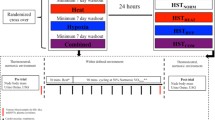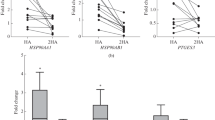Abstract
Heat shock protein 72 (HSP72) performs vital roles within the body at rest and during periods of stress. In vitro, research demonstrates HSP72 induction in response to hypoxia. Recently, in vivo, an acute hypoxic exposure (75 min at 2,980 m) was sufficient to induce significant increases in monocyte expressed HSP72 (mHSP72) and a marker of oxidative stress in healthy human subjects. The purpose of the current study was to identify the impact of 10 consecutive days of hypoxic exposures (75 min at 2,980 m) on mHSP72 and erythropoietin (EPO) expression, markers of oxidative stress, and maximal oxygen consumption in graded incremental aerobic exercise. Eight male subjects were exposed to daily normobaric hypoxic exposures for 75 min at 2,980 m for 10 consecutive days, commencing and ceasing at 0930 and 1045, respectively. This stressor was sufficient to induce significant increases in mHSP72, which was significantly elevated from day 2 of the hypoxic exposures until 48 h post-final exposure. Notably, this increase had an initial rapid (30% day on day compared to baseline) and final slow phase (16% day on day compared to baseline) of expression. The authors postulate that 7-day hypoxic exposure in this manner would be sufficient to induce near maximum hypoxia-mediated basal mHSP72 expression. Elevated levels of mHSP72 are associated with acquired thermotolerance and provide cross tolerance to non-related stressors in vivo, the protocol used here may provide a useful tool for elevating mHSP72 in vivo. Aside from these major findings, significant transient daily elevations were seen in a marker of oxidative stress, alongside sustained increases in EPO expression. However, no physiologically significant changes were seen in maximal oxygen consumption or time to exhaustion.





Similar content being viewed by others
References
Abbrecht PH, Kittell JK (1972) Plasma erythropoietin in men and mice during acclimatization to different altitudes. J Appl Physiol 32:54–59
Ahn SG, Thiele DJ (2003) Redox regulation of mammalian heat shock factor 1 is essential for hsp gene activation and protection from stress. Gen Dev 17:516–528
Allen RG, Balin AK (1989) Oxidative influence on development and differentiation—an overview of a free-radical theory of development. Free Radic Bio Med 6:631–661
Anbarasi K, Kathirvel G, Vani G, Jayaraman G, Devi CSS (2006) Cigarette smoking induces heat shock protein 70 kda expression and apoptosis in rat brain: modulation by bacoside A. Neuroscience 138:1127–1135
Arieli Y, Eynan M, Gancz H, Arieli R, Kashi Y (2003) Heat acclimation prolongs the time to central nervous system oxygen toxicity in the rat—possible involvement of hsp72. Brain Res 962:15–20
Bailey DM, Davies B, Young IS (2001) Intermittent hypoxic training: Implications for lipid peroxidation induced by acute normoxic exercise in active men. Clin Sci 101:465–475
Bartsch P, Dehnert C, Friedmann-Bette B, Tadibi V (2007) Intermittent hypoxia at rest for improvement of athletic performance. Consensus meeting on football at high altitude. Zurich, Switzerland
Berglund B, Gennser M, Ornhagen H, Ostberg C, Wide L (2002) Erythropoietin concentrations during 10 days of normobaric hypoxia under controlled environmental circumstances. Acta Physiol Scand 174:225–229
Bienemann AS, Lee YB, Howarth J, Uney JB (2008) Hsp70 suppresses apoptosis in sympathetic neurones by preventing the activation of c-jun. J Neurochem 104:271–278
Clanton TL (2007) Hypoxia-induced reactive oxygen species formation in skeletal muscle. J Appl Physiol 102:2379–2388
Fehrenbach E, Niess AM, Schlotz E, Passek F, Dickhuth HH, Northoff H (2000) Transcriptional and translational regulation of heat shock proteins in leukocytes of endurance runners. J Appl Physiol 89:704–710
Fehrenbach E, Niess AM, Veith R, Dickhuth HH, Northoff H (2001) Changes of hsp72-expression in leukocytes are associated with adaptation to exercise under conditions of high environmental temperature. J Leukoc Biol 69:747–754
Fink AL (1999) Chaperone-mediated protein folding. Physiol Rev 79:425–449
Fisher-Wellman K, Bloomer R (2009) Acute exercise and oxidative stress: a 30 year history. Dyn Med 8:1
Fortes MB, Whitham M (2009) No endogenous circadian rhythm in resting plasma hsp72 concentration in humans. Cell Stress Chaperon 14:273–280
Garramone RR, Winters RM, Das DK, Deckers PJ (1994) Reduction of skeletal-muscle injury through stress conditioning using the heat-shock response. Plast Reconstr Surg 93:1242–1247
Garrido C, Gurbuxani S, Ravagnan L, Kroemer G (2001) Heat shock proteins: endogenous modulators of apoptotic cell death. Biochem Biophys Res Commun 286:433–442
Gjovaag TF, Dahl HA (2006) Effect of training and detraining on the expression of heat shock proteins in m. Triceps brachii of untrained males and females. Eur J Appl Physiol 98:310–322
Hamlin MJ, Hellemans J (2007) Effect of intermittent normobaric hypoxic exposure at rest on haematological, physiological, and performance parameters in multi-sport athletes. Sport Sci 25:431–441
Hartl FU (1996) Molecular chaperones in cellular protein folding. Nature 381:571–580
Horowitz M (2002) From molecular and cellular to integrative heat defense during exposure to chronic heat. Comp Biochem Phys A 131:475–483
Horowitz M, Eli-Berchoer L, Wapinski I, Friedman N, Kodesh E (2004) Stress-related genomic responses during the course of heat acclimation and its association with ischemic-reperfusion cross-tolerance. J Appl Physiol 97:1496–1507
Katayama K, Matsuo H, Ishida K, Mori S, Miyamura M (2003) Intermittent hypoxia improves endurance performance and submaximal exercise efficiency. High Alt Med Biol 4:291–304
Katayama K, Sato K, Matsuo H, Ishida K, Iwasaki K, Miyamura M (2004) Effect of intermittent hypoxia on oxygen uptake during submaximal exercise in endurance athletes. Eur J Appl Physiol 92:75–83
Kiang JG, Wang XD, Ding XZ, Gist ID, Smallridge RC (1996) Heat shock inhibits the hypoxia-induced effects on iodide uptake and signal transduction and enhances cell survival in rat thyroid frtl-5 cells. Thyroid 6:475–483
Kregel KC (2002) Heat shock proteins: modifying factors in physiological stress responses and acquired thermotolerance. J Appl Physiol 92:2177–2186
Kukreja RC, Kontos MC, Loesser KE, Batra SK, Qian YZ, Gbur CJ, Naseem SA, Jesse RL, Hess ML (1994) Oxidant stress increases heat shock protein 70 mrna in isolated perfused rat heart. Am J Physiol Cell Physiol 267:H2213–H2219
Kulkarni AC, Kuppusamy P, Parinandi N (2007) Oxygen, the lead actor in the pathophysiologic drama: enactment of the trinity of normoxia, hypoxia, and hyperoxia in disease and therapy. Antioxid Redox Signal 9:1717–1730
Levine BD (2002) Intermittent hypoxic training: fact and fancy. High Alt Med Biol 3:177–193
Levine BD, Stray-Gundersen J (1997) ‘‘living high training low’’: effect of moderate-altitude acclimatization with low-altitude training on performance. J Appl Physiol 83:102–112
Locke M, Noble EG (1995) Stress proteins—the exercise response. Can J Appl Physiol 20:155–167
Lu PZ, Lai CY, Chan WH (2008) Caffeine induces cell death via activation of apoptotic signal and inactivation of survival signal in human osteoblasts. Int J Mol Sci 9:698–718
Lundby C, Nielsen TK, Dela F, Damsgaard R (2005) The influence of intermittent altitude exposure to 4100 m on exercise capacity and blood variables. Scand J Med Sci Sports 15:182–187
Madden LA, Vince RV, Sandstroem ME, Taylor L, Mcnaughton L, Laden G (2008) Microparticle-associated vascular adhesion molecule-i and tissue factor follow a circadian rhythm in healthy human subjects. Thromb Haemost 99:909–915
Marshall HC, Campbell SA, Roberts CW, Nimmo MA (2007) Human physiological and heat shock protein 72 adaptations during the initial phase of humid-heat acclimation. J Therm Biol 32:341–348
Maulik N (2002) Redox signaling of angiogenesis. Antioxid Redox Signal 4:805–815
Mcardle F, Spiers S, Aldemir H, Vasilaki A, Beaver A, Iwanejko L, Mcardle A, Jackson MJ (2004) Preconditioning of skeletal muscle against contraction-induced damage: the role of adaptations to oxidants in mice. J Physiol (London) 561:233–244
Mcclung JP, Hasday JD, He JR, Montain SJ, Cheuvront SN, Sawka MN, Singh IS (2008) Exercise-heat acclimation in humans alters baseline levels and ex vivo heat inducibility of hsp72 and hsp90 in peripheral blood mononuclear cells. Am J Physiol Regul I 294:R185–R191
Mcnicol AJ, O’Brien BJ, Paton CD, Knez WL (2009) The effects of increased absolute training intensity on adaptations to endurance exercise training. J Sci Med Sport 12:485–489
Morimoto RI (1998) Regulation of the heat shock transcriptional response: cross talk between a family of heat shock factors, molecular chaperones, and negative regulators. Gen Dev 12:3788–3796
Morton JP, Maclaren DP, Cable NT, Bongers T, Griffiths RD, Campbell IT, Evans L, Kayani A, Mcardle A, Drust B (2006) Time course and differential responses of the major heat shock protein families in human skeletal muscle following acute nondamaging treadmill exercise. J Appl Physiol 101:176–182
Morton JP, Maclaren DPM, Cable NT, Campbell IT, Evans L, Bongers T, Griffiths RD, Kayani AC, Mcardle A, Drust B (2007) Elevated core and muscle temperature to levels comparable to exercise do not increase heat shock protein content of skeletal muscle of physically active men. Acta Physiol Scand 190:319–327
Morton JP, Kayani A, Mcardle A, Drust B (2009) The exercise-induced stress response of skeletal muscle, with specific emphasis on humans. Sports Med 39:643–662
Richard V, Kaeffer N, Thuillez C (1996) Delayed protection of the ischemic heart—from pathophysiology to therapeutic applications. Fundam Clin Pharmacol 10:409–415
Ritossa F (1962) A new puffing induced by temperature shock and DNP in Drosophila. Experientia 15:571
Rodriguez FA, Truijens MJ, Townsend NE, Stray-Gundersen J, Gore CJ, Levine BD (2007) Performance of runners and swimmers after four weeks of intermittent hypobaric hypoxic exposure plus sea level training. J Appl Physiol 103:1523–1535
Rodriguez FA, Ventura JL, Casas M, Casas H, Pages T, Rama R, Ricart A (2000) Erythropoietin acute reaction and haematological adaptations to short, intermittent hypobaric hypoxia. Eur J Appl Physiol 82:170–177
Sandstrom ME, Madden LA, Taylor L, Siegler JC, Lovell RJ, Midgley AW, McNaughton L (2009) Variation in basal heat shock protein 70 is correlated to core temperature in human subjects. Amino Acids 37:279
Sandstrom ME, Siegler JC, Lovell RJ, Madden LA, McNaughton L (2008) The effect of 15 consecutive days of heat-exercise acclimation on heat shock protein 70. Cell Stress Chaperon 13:169–175
Serebrovskaya TV (2002) Intermittent hypoxia research in the former Soviet Union and the commonwealth of independent states: history and review of the concept and selected applications. High Alt Med Biol 3:205–221
Shein NA, Horowitz M, Alexandrovich AG, Tsenter J, Shohami E (2005) Heat acclimation increases hypoxia-inducible factor 1 alpha and erythropoietin receptor expression: Implication for neuroprotection after closed head injury in mice. J Cerebr Blood Flow Metab 25:1456–1465
Shein NA, Horowitz M, Shohami E (2007) Heat acclimation: a unique model of physiologically mediated global preconditioning against traumatic brain injury. In: Weber JT, Maas AIR (eds) Neurotrauma: new insights into pathology and treatment
Singleton KD, Ziegler TR, Luo M, Fernandez-Estivariz C, Wischmeyer PE (2004) Intravenous glutamine increases serum hsp 72 levels in both humans and rodents following systemic inflammation. In: 27th annual conference on shock. Halifax, Canada
Taylor L, Midgley A, Chrismas B, Madden L, Vince RV, Mcnaughton L (2010a) Daily quadratic trend in basal monocyte expressed hsp72 in healthy human subjects. Amino Acids 38:1483–1488
Taylor L, Midgley A, Chrismas B, Madden L, Vince RV, McNaughton L (2010b) The effect of acute hypoxia on heat shock protein 72 expression and oxidative stress in vivo. Eur J Appl Physiol. doi:10.1007/s00421-010-1430-x
Vince RV, McNaughton L, Taylor L, Midgley AW, Laden G, Madden LA (2009) Release of vcam-1 associated endothelial microparticles following simulated scuba dives. Eur J Appl Physiol 105:507–513
Vince RV, Oliver K, Midgley A, Mcnaughton L, Madden L (2010) In vitro heat shock of human monocytes results in a proportional increase of inducible hsp70 expression according to the basal content. Amino Acids 38:1423–1428
Yang XM, Baxter GF, Heads RJ, Yellon DM, Downey JM, Cohen MV (1996) Infarct limitation of the second window of protection in a conscious rabbit model. Cardiovasc Res 31:777–783
Author information
Authors and Affiliations
Corresponding author
Rights and permissions
About this article
Cite this article
Taylor, L., Midgley, A.W., Chrismas, B. et al. Daily hypoxia increases basal monocyte HSP72 expression in healthy human subjects. Amino Acids 40, 393–401 (2011). https://doi.org/10.1007/s00726-010-0644-x
Received:
Accepted:
Published:
Issue Date:
DOI: https://doi.org/10.1007/s00726-010-0644-x




